本文转自Rancher Labs
介 绍
Prometheus高可用的必要性
在过去的几年里,Kubernetes的采用量增长了数倍。很明显,Kubernetes是容器编排的不二选择。与此同时,Prometheus也被认为是监控容器化和非容器化工作负载的绝佳选择。监控是任何基础设施的一个重要关注点,我们应该确保我们的监控设置具有高可用性和高可扩展性,以满足不断增长的基础设施的需求,特别是在采用Kubernetes的情况下。
因此,今天我们将部署一个集群化的Prometheus设置,它不仅能够弹性应对节点故障,还能保证合适的数据存档,供以后参考。我们的设置还具有很强的可扩展性,以至于我们可以在同一个监控保护伞下跨越多个Kubernetes集群。
当前方案
大部分的Prometheus部署都是使用持久卷的pod,而Prometheus则是使用联邦机制进行扩展。但是并不是所有的数据都可以使用联邦机制进行聚合,在这里,当你增加额外的服务器时,你往往需要一个机制来管理Prometheus配置。
解决方法
Thanos旨在解决上述问题。在Thanos的帮助下,我们不仅可以对Prometheus的实例进行多重复制,并在它们之间进行数据去重,还可以将数据归档到GCS或S3等长期存储中。
实施过程
Thanos 架构
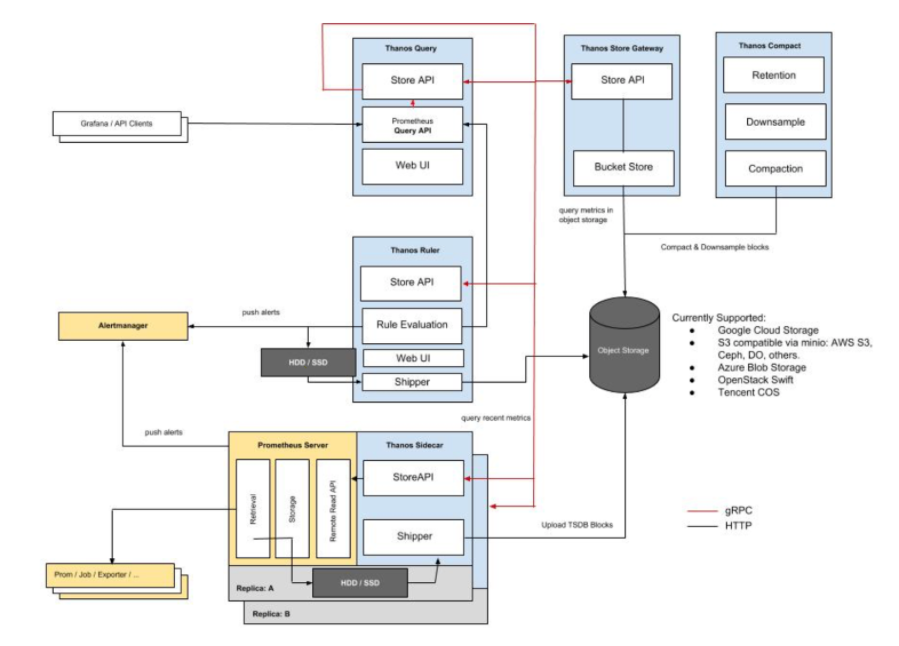
图片来源: https://thanos.io/quick-tutorial.md/
Thanos由以下组件构成:
-
Thanos sidecar:这是运行在Prometheus上的主要组件。它读取和归档对象存储上的数据。此外,它还管理着Prometheus的配置和生命周期。为了区分每个Prometheus实例,sidecar组件将外部标签注入到Prometheus配置中。该组件能够在 Prometheus 服务器的 PromQL 接口上运行查询。Sidecar组件还能监听Thanos gRPC协议,并在gRPC和REST之间翻译查询。
-
Thanos 存储:该组件在对象storage bucket中的历史数据之上实现了Store API,它主要作为API网关,因此不需要大量的本地磁盘空间。它在启动时加入一个Thanos集群,并公布它可以访问的数据。它在本地磁盘上保存了少量关于所有远程区块的信息,并使其与 bucket 保持同步。通常情况下,在重新启动时可以安全地删除此数据,但会增加启动时间。
-
Thanos查询:查询组件在HTTP上监听并将查询翻译成Thanos gRPC格式。它从不同的源头汇总查询结果,并能从Sidecar和Store读取数据。在HA设置中,它甚至会对查询结果进行重复数据删除。
HA组的运行时重复数据删除
Prometheus是有状态的,不允许复制其数据库。这意味着通过运行多个Prometheus副本来提高高可用性并不易于使用。简单的负载均衡是行不通的,比如在发生某些崩溃之后,一个副本可能会启动,但是查询这样的副本会导致它在关闭期间出现一个小的缺口(gap)。你有第二个副本可能正在启动,但它可能在另一个时刻(如滚动重启)关闭,因此在这些副本上面的负载均衡将无法正常工作。
-
Thanos Querier则从两个副本中提取数据,并对这些信号进行重复数据删除,从而为Querier使用者填补了缺口(gap)。
-
Thanos Compact组件将Prometheus 2.0存储引擎的压实程序应用于对象存储中的块数据存储。它通常不是语义上的并发安全,必须针对bucket 进行单例部署。它还负责数据的下采样——40小时后执行5m下采样,10天后执行1h下采样。
-
Thanos Ruler基本上和Prometheus的规则具有相同作用,唯一区别是它可以与Thanos组件进行通信。
配 置
前期准备
要完全理解这个教程,需要准备以下东西:
-
对Kubernetes和使用kubectl有一定的了解。
-
运行中的Kubernetes集群至少有3个节点(在本demo中,使用GKE集群)
-
实现Ingress Controller和Ingress对象(在本demo中使用Nginx Ingress Controller)。虽然这不是强制性的,但为了减少创建外部端点的数量,强烈建议使用。
-
创建用于Thanos组件访问对象存储的凭证(在本例中为GCS bucket)。
-
创建2个GCS bucket,并将其命名为Prometheus-long-term和thanos-ruler。
-
创建一个服务账户,角色为Storage Object Admin。
-
下载密钥文件作为json证书,并命名为thanos-gcs-credentials.json。
-
使用凭证创建Kubernetes sercret
kubectl create secret generic thanos-gcs-credentials --from-file=thanos-gcs-credentials.json
部署各类组件
部署Prometheus服务账户、Clusterroler和Clusterrolebinding
apiVersion: v1
kind: Namespace
metadata:
name: monitoring
---
apiVersion: v1
kind: ServiceAccount
metadata:
name: monitoring
namespace: monitoring
---
apiVersion: rbac.authorization.k8s.io/v1beta1
kind: ClusterRole
metadata:
name: monitoring
namespace: monitoring
rules:
- apiGroups: [""]
resources:
- nodes
- nodes/proxy
- services
- endpoints
- pods
verbs: ["get", "list", "watch"]
- apiGroups: [""]
resources:
- configmaps
verbs: ["get"]
- nonResourceURLs: ["/metrics"]
verbs: ["get"]
---
apiVersion: rbac.authorization.k8s.io/v1beta1
kind: ClusterRoleBinding
metadata:
name: monitoring
subjects:
- kind: ServiceAccount
name: monitoring
namespace: monitoring
roleRef:
kind: ClusterRole
Name: monitoring
apiGroup: rbac.authorization.k8s.io
---
以上manifest创建了Prometheus所需的监控命名空间以及服务账户、clusterrole以及clusterrolebinding。
部署Prometheues配置configmap
apiVersion: v1
kind: ConfigMap
metadata:
name: prometheus-server-conf
labels:
name: prometheus-server-conf
namespace: monitoring
data:
prometheus.yaml.tmpl: |-
global:
scrape_interval: 5s
evaluation_interval: 5s
external_labels:
cluster: prometheus-ha
# Each Prometheus has to have unique labels.
replica: $(POD_NAME)
rule_files:
- /etc/prometheus/rules/*rules.yaml
alerting:
# We want our alerts to be deduplicated
# from different replicas.
alert_relabel_configs:
- regex: replica
action: labeldrop
alertmanagers:
- scheme: http
path_prefix: /
static_configs:
- targets: ['alertmanager:9093']
scrape_configs:
- job_name: kubernetes-nodes-cadvisor
scrape_interval: 10s
scrape_timeout: 10s
scheme: https
tls_config:
ca_file: /var/run/secrets/kubernetes.io/serviceaccount/ca.crt
bearer_token_file: /var/run/secrets/kubernetes.io/serviceaccount/token
kubernetes_sd_configs:
- role: node
relabel_configs:
- action: labelmap
regex: __meta_kubernetes_node_label_(.+)
# Only for Kubernetes ^1.7.3.
# See: https://github.com/prometheus/prometheus/issues/2916
- target_label: __address__
replacement: kubernetes.default.svc:443
- source_labels: [__meta_kubernetes_node_name]
regex: (.+)
target_label: __metrics_path__
replacement: /api/v1/nodes/${1}/proxy/metrics/cadvisor
metric_relabel_configs:
- action: replace
source_labels: [id]
regex: '^/machine.slice/machine-rkt\x2d([^\]+)\.+/([^/]+).service$'
target_label: rkt_container_name
replacement: '${2}-${1}'
- action: replace
source_labels: [id]
regex: '^/system.slice/(.+).service$'
target_label: systemd_service_name
replacement: '${1}'
- job_name: 'kubernetes-pods'
kubernetes_sd_configs:
- role: pod
relabel_configs:
- action: labelmap
regex: __meta_kubernetes_pod_label_(.+)
- source_labels: [__meta_kubernetes_namespace]
action: replace
target_label: kubernetes_namespace
- source_labels: [__meta_kubernetes_pod_name]
action: replace
target_label: kubernetes_pod_name
- source_labels: [__meta_kubernetes_pod_annotation_prometheus_io_scrape]
action: keep
regex: true
- source_labels: [__meta_kubernetes_pod_annotation_prometheus_io_scheme]
action: replace
target_label: __scheme__
regex: (https?)
- source_labels: [__meta_kubernetes_pod_annotation_prometheus_io_path]
action: replace
target_label: __metrics_path__
regex: (.+)
- source_labels: [__address__, __meta_kubernetes_pod_prometheus_io_port]
action: replace
target_label: __address__
regex: ([^:]+)(?::d+)?;(d+)
replacement: $1:$2
- job_name: 'kubernetes-apiservers'
kubernetes_sd_configs:
- role: endpoints
scheme: https
tls_config:
ca_file: /var/run/secrets/kubernetes.io/serviceaccount/ca.crt
bearer_token_file: /var/run/secrets/kubernetes.io/serviceaccount/token
relabel_configs:
- source_labels: [__meta_kubernetes_namespace, __meta_kubernetes_service_name, __meta_kubernetes_endpoint_port_name]
action: keep
regex: default;kubernetes;https
- job_name: 'kubernetes-service-endpoints'
kubernetes_sd_configs:
- role: endpoints
relabel_configs:
- action: labelmap
regex: __meta_kubernetes_service_label_(.+)
- source_labels: [__meta_kubernetes_namespace]
action: replace
target_label: kubernetes_namespace
- source_labels: [__meta_kubernetes_service_name]
action: replace
target_label: kubernetes_name
- source_labels: [__meta_kubernetes_service_annotation_prometheus_io_scrape]
action: keep
regex: true
- source_labels: [__meta_kubernetes_service_annotation_prometheus_io_scheme]
action: replace
target_label: __scheme__
regex: (https?)
- source_labels: [__meta_kubernetes_service_annotation_prometheus_io_path]
action: replace
target_label: __metrics_path__
regex: (.+)
- source_labels: [__address__, __meta_kubernetes_service_annotation_prometheus_io_port]
action: replace
target_label: __address__
regex: (.+)(?::d+);(d+)
replacement: $1:$2
上述Configmap创建了Prometheus配置文件模板。这个配置文件模板将被Thanos sidecar组件读取,它将生成实际的配置文件,而这个配置文件又将被运行在同一个pod中的Prometheus容器所消耗。在配置文件中添加external_labels部分是极其重要的,这样Querier就可以根据这个来重复删除数据。
部署Prometheus Rules configmap
这将创建我们的告警规则,这些规则将被转发到alertmanager,以便发送。
apiVersion: v1
kind: ConfigMap
metadata:
name: prometheus-rules
labels:
name: prometheus-rules
namespace: monitoring
data:
alert-rules.yaml: |-
groups:
- name: Deployment
rules:
- alert: Deployment at 0 Replicas
annotations:
summary: Deployment {{$labels.deployment}} in {{$labels.namespace}} is currently having no pods running
expr: |
sum(kube_deployment_status_replicas{pod_template_hash=""}) by (deployment,namespace) < 1
for: 1m
labels:
team: devops
- alert: HPA Scaling Limited
annotations:
summary: HPA named {{$labels.hpa}} in {{$labels.namespace}} namespace has reached scaling limited state
expr: |
(sum(kube_hpa_status_condition{condition="ScalingLimited",status="true"}) by (hpa,namespace)) == 1
for: 1m
labels:
team: devops
- alert: HPA at MaxCapacity
annotations:
summary: HPA named {{$labels.hpa}} in {{$labels.namespace}} namespace is running at Max Capacity
expr: |
((sum(kube_hpa_spec_max_replicas) by (hpa,namespace)) - (sum(kube_hpa_status_current_replicas) by (hpa,namespace))) == 0
for: 1m
labels:
team: devops
- name: Pods
rules:
- alert: Container restarted
annotations:
summary: Container named {{$labels.container}} in {{$labels.pod}} in {{$labels.namespace}} was restarted
expr: |
sum(increase(kube_pod_container_status_restarts_total{namespace!="kube-system",pod_template_hash=""}[1m])) by (pod,namespace,container) > 0
for: 0m
labels:
team: dev
- alert: High Memory Usage of Container
annotations:
summary: Container named {{$labels.container}} in {{$labels.pod}} in {{$labels.namespace}} is using more than 75% of Memory Limit
expr: |
((( sum(container_memory_usage_bytes{image!="",container_name!="POD", namespace!="kube-system"}) by (namespace,container_name,pod_name) / sum(container_spec_memory_limit_bytes{image!="",container_name!="POD",namespace!="kube-system"}) by (namespace,container_name,pod_name) ) * 100 ) < +Inf ) > 75
for: 5m
labels:
team: dev
- alert: High CPU Usage of Container
annotations:
summary: Container named {{$labels.container}} in {{$labels.pod}} in {{$labels.namespace}} is using more than 75% of CPU Limit
expr: |
((sum(irate(container_cpu_usage_seconds_total{image!="",container_name!="POD", namespace!="kube-system"}[30s])) by (namespace,container_name,pod_name) / sum(container_spec_cpu_quota{image!="",container_name!="POD", namespace!="kube-system"} / container_spec_cpu_period{image!="",container_name!="POD", namespace!="kube-system"}) by (namespace,container_name,pod_name) ) * 100) > 75
for: 5m
labels:
team: dev
- name: Nodes
rules:
- alert: High Node Memory Usage
annotations:
summary: Node {{$labels.kubernetes_io_hostname}} has more than 80% memory used. Plan Capcity
expr: |
(sum (container_memory_working_set_bytes{id="/",container_name!="POD"}) by (kubernetes_io_hostname) / sum (machine_memory_bytes{}) by (kubernetes_io_hostname) * 100) > 80
for: 5m
labels:
team: devops
- alert: High Node CPU Usage
annotations:
summary: Node {{$labels.kubernetes_io_hostname}} has more than 80% allocatable cpu used. Plan Capacity.
expr: |
(sum(rate(container_cpu_usage_seconds_total{id="/", container_name!="POD"}[1m])) by (kubernetes_io_hostname) / sum(machine_cpu_cores) by (kubernetes_io_hostname) * 100) > 80
for: 5m
labels:
team: devops
- alert: High Node Disk Usage
annotations:
summary: Node {{$labels.kubernetes_io_hostname}} has more than 85% disk used. Plan Capacity.
expr: |
(sum(container_fs_usage_bytes{device=~"^/dev/[sv]d[a-z][1-9]$",id="/",container_name!="POD"}) by (kubernetes_io_hostname) / sum(container_fs_limit_bytes{container_name!="POD",device=~"^/dev/[sv]d[a-z][1-9]$",id="/"}) by (kubernetes_io_hostname)) * 100 > 85
for: 5m
labels:
team: devops
部署Prometheus Stateful Set
apiVersion: storage.k8s.io/v1beta1
kind: StorageClass
metadata:
name: fast
namespace: monitoring
provisioner: kubernetes.io/gce-pd
allowVolumeExpansion: true
---
apiVersion: apps/v1beta1
kind: StatefulSet
metadata:
name: prometheus
namespace: monitoring
spec:
replicas: 3
serviceName: prometheus-service
template:
metadata:
labels:
app: prometheus
thanos-store-api: "true"
spec:
serviceAccountName: monitoring
containers:
- name: prometheus
image: prom/prometheus:v2.4.3
args:
- "--config.file=/etc/prometheus-shared/prometheus.yaml"
- "--storage.tsdb.path=/prometheus/"
- "--web.enable-lifecycle"
- "--storage.tsdb.no-lockfile"
- "--storage.tsdb.min-block-duration=2h"
- "--storage.tsdb.max-block-duration=2h"
ports:
- name: prometheus
containerPort: 9090
volumeMounts:
- name: prometheus-storage
mountPath: /prometheus/
- name: prometheus-config-shared
mountPath: /etc/prometheus-shared/
- name: prometheus-rules
mountPath: /etc/prometheus/rules
- name: thanos
image: quay.io/thanos/thanos:v0.8.0
args:
- "sidecar"
- "--log.level=debug"
- "--tsdb.path=/prometheus"
- "--prometheus.url=http://127.0.0.1:9090"
- "--objstore.config={type: GCS, config: {bucket: prometheus-long-term}}"
- "--reloader.config-file=/etc/prometheus/prometheus.yaml.tmpl"
- "--reloader.config-envsubst-file=/etc/prometheus-shared/prometheus.yaml"
- "--reloader.rule-dir=/etc/prometheus/rules/"
env:
- name: POD_NAME
valueFrom:
fieldRef:
fieldPath: metadata.name
- name : GOOGLE_APPLICATION_CREDENTIALS
value: /etc/secret/thanos-gcs-credentials.json
ports:
- name: http-sidecar
containerPort: 10902
- name: grpc
containerPort: 10901
livenessProbe:
httpGet:
port: 10902
path: /-/healthy
readinessProbe:
httpGet:
port: 10902
path: /-/ready
volumeMounts:
- name: prometheus-storage
mountPath: /prometheus
- name: prometheus-config-shared
mountPath: /etc/prometheus-shared/
- name: prometheus-config
mountPath: /etc/prometheus
- name: prometheus-rules
mountPath: /etc/prometheus/rules
- name: thanos-gcs-credentials
mountPath: /etc/secret
readOnly: false
securityContext:
fsGroup: 2000
runAsNonRoot: true
runAsUser: 1000
volumes:
- name: prometheus-config
configMap:
defaultMode: 420
name: prometheus-server-conf
- name: prometheus-config-shared
emptyDir: {}
- name: prometheus-rules
configMap:
name: prometheus-rules
- name: thanos-gcs-credentials
secret:
secretName: thanos-gcs-credentials
volumeClaimTemplates:
- metadata:
name: prometheus-storage
namespace: monitoring
spec:
accessModes: [ "ReadWriteOnce" ]
storageClassName: fast
resources:
requests:
storage: 20Gi
关于上面提供的manifest,理解以下内容很重要:
-
Prometheus是作为一个有状态集部署的,有3个副本,每个副本动态地提供自己的持久化卷。
-
Prometheus配置是由Thanos sidecar容器使用我们上面创建的模板文件生成的。
-
Thanos处理数据压缩,因此我们需要设置--storage.tsdb.min-block-duration=2h和--storage.tsdb.max-block-duration=2h。
-
Prometheus有状态集被标记为thanos-store-api: true,这样每个pod就会被我们接下来创建的headless service发现。正是这个headless service将被Thanos Querier用来查询所有Prometheus实例的数据。我们还将相同的标签应用于Thanos Store和Thanos Ruler组件,这样它们也会被Querier发现,并可用于查询指标。
-
GCS bucket credentials路径是使用GOOGLE_APPLICATION_CREDENTIALS环境变量提供的,配置文件是由我们作为前期准备中创建的secret挂载到它上面的。
部署Prometheus服务
apiVersion: v1
kind: Service
metadata:
name: prometheus-0-service
annotations:
prometheus.io/scrape: "true"
prometheus.io/port: "9090"
namespace: monitoring
labels:
name: prometheus
spec:
selector:
statefulset.kubernetes.io/pod-name: prometheus-0
ports:
- name: prometheus
port: 8080
targetPort: prometheus
---
apiVersion: v1
kind: Service
metadata:
name: prometheus-1-service
annotations:
prometheus.io/scrape: "true"
prometheus.io/port: "9090"
namespace: monitoring
labels:
name: prometheus
spec:
selector:
statefulset.kubernetes.io/pod-name: prometheus-1
ports:
- name: prometheus
port: 8080
targetPort: prometheus
---
apiVersion: v1
kind: Service
metadata:
name: prometheus-2-service
annotations:
prometheus.io/scrape: "true"
prometheus.io/port: "9090"
namespace: monitoring
labels:
name: prometheus
spec:
selector:
statefulset.kubernetes.io/pod-name: prometheus-2
ports:
- name: prometheus
port: 8080
targetPort: prometheus
---
#This service creates a srv record for querier to find about store-api's
apiVersion: v1
kind: Service
metadata:
name: thanos-store-gateway
namespace: monitoring
spec:
type: ClusterIP
clusterIP: None
ports:
- name: grpc
port: 10901
targetPort: grpc
selector:
thanos-store-api: "true"
除了上述方法外,你还可以点击这篇文章了解如何在Rancher上快速部署和配置Prometheus服务。
我们为stateful set中的每个Prometheus pod创建了不同的服务,尽管这并不是必要的。这些服务的创建只是为了调试。上文已经解释了 thanos-store-gateway headless service的目的。我们稍后将使用一个 ingress 对象来暴露 Prometheus 服务。
部署Prometheus Querier
apiVersion: v1
kind: Namespace
metadata:
name: monitoring
---
apiVersion: apps/v1
kind: Deployment
metadata:
name: thanos-querier
namespace: monitoring
labels:
app: thanos-querier
spec:
replicas: 1
selector:
matchLabels:
app: thanos-querier
template:
metadata:
labels:
app: thanos-querier
spec:
containers:
- name: thanos
image: quay.io/thanos/thanos:v0.8.0
args:
- query
- --log.level=debug
- --query.replica-label=replica
- --store=dnssrv+thanos-store-gateway:10901
ports:
- name: http
containerPort: 10902
- name: grpc
containerPort: 10901
livenessProbe:
httpGet:
port: http
path: /-/healthy
readinessProbe:
httpGet:
port: http
path: /-/ready
---
apiVersion: v1
kind: Service
metadata:
labels:
app: thanos-querier
name: thanos-querier
namespace: monitoring
spec:
ports:
- port: 9090
protocol: TCP
targetPort: http
name: http
selector:
app: thanos-querier
这是Thanos部署的主要内容之一。请注意以下几点:
-
容器参数
-store=dnssrv+thanos-store-gateway:10901有助于发现所有应查询的指标数据的组件。 -
thanos-querier服务提供了一个Web接口来运行PromQL查询。它还可以选择在不同的Prometheus集群中去重复删除数据。
-
这是我们提供Grafana作为所有dashboard的数据源的终点(end point)。
部署Thanos存储网关
apiVersion: v1
kind: Namespace
metadata:
name: monitoring
---
apiVersion: apps/v1beta1
kind: StatefulSet
metadata:
name: thanos-store-gateway
namespace: monitoring
labels:
app: thanos-store-gateway
spec:
replicas: 1
selector:
matchLabels:
app: thanos-store-gateway
serviceName: thanos-store-gateway
template:
metadata:
labels:
app: thanos-store-gateway
thanos-store-api: "true"
spec:
containers:
- name: thanos
image: quay.io/thanos/thanos:v0.8.0
args:
- "store"
- "--log.level=debug"
- "--data-dir=/data"
- "--objstore.config={type: GCS, config: {bucket: prometheus-long-term}}"
- "--index-cache-size=500MB"
- "--chunk-pool-size=500MB"
env:
- name : GOOGLE_APPLICATION_CREDENTIALS
value: /etc/secret/thanos-gcs-credentials.json
ports:
- name: http
containerPort: 10902
- name: grpc
containerPort: 10901
livenessProbe:
httpGet:
port: 10902
path: /-/healthy
readinessProbe:
httpGet:
port: 10902
path: /-/ready
volumeMounts:
- name: thanos-gcs-credentials
mountPath: /etc/secret
readOnly: false
volumes:
- name: thanos-gcs-credentials
secret:
secretName: thanos-gcs-credentials
---
这将创建存储组件,它将从对象存储中向Querier提供指标。
部署Thanos Ruler
apiVersion: v1
kind: Namespace
metadata:
name: monitoring
---
apiVersion: v1
kind: ConfigMap
metadata:
name: thanos-ruler-rules
namespace: monitoring
data:
alert_down_services.rules.yaml: |
groups:
- name: metamonitoring
rules:
- alert: PrometheusReplicaDown
annotations:
message: Prometheus replica in cluster {{$labels.cluster}} has disappeared from Prometheus target discovery.
expr: |
sum(up{cluster="prometheus-ha", instance=~".*:9090", job="kubernetes-service-endpoints"}) by (job,cluster) < 3
for: 15s
labels:
severity: critical
---
apiVersion: apps/v1beta1
kind: StatefulSet
metadata:
labels:
app: thanos-ruler
name: thanos-ruler
namespace: monitoring
spec:
replicas: 1
selector:
matchLabels:
app: thanos-ruler
serviceName: thanos-ruler
template:
metadata:
labels:
app: thanos-ruler
thanos-store-api: "true"
spec:
containers:
- name: thanos
image: quay.io/thanos/thanos:v0.8.0
args:
- rule
- --log.level=debug
- --data-dir=/data
- --eval-interval=15s
- --rule-file=/etc/thanos-ruler/*.rules.yaml
- --alertmanagers.url=http://alertmanager:9093
- --query=thanos-querier:9090
- "--objstore.config={type: GCS, config: {bucket: thanos-ruler}}"
- --label=ruler_cluster="prometheus-ha"
- --label=replica="$(POD_NAME)"
env:
- name : GOOGLE_APPLICATION_CREDENTIALS
value: /etc/secret/thanos-gcs-credentials.json
- name: POD_NAME
valueFrom:
fieldRef:
fieldPath: metadata.name
ports:
- name: http
containerPort: 10902
- name: grpc
containerPort: 10901
livenessProbe:
httpGet:
port: http
path: /-/healthy
readinessProbe:
httpGet:
port: http
path: /-/ready
volumeMounts:
- mountPath: /etc/thanos-ruler
name: config
- name: thanos-gcs-credentials
mountPath: /etc/secret
readOnly: false
volumes:
- configMap:
name: thanos-ruler-rules
name: config
- name: thanos-gcs-credentials
secret:
secretName: thanos-gcs-credentials
---
apiVersion: v1
kind: Service
metadata:
labels:
app: thanos-ruler
name: thanos-ruler
namespace: monitoring
spec:
ports:
- port: 9090
protocol: TCP
targetPort: http
name: http
selector:
app: thanos-ruler
现在,如果你在与我们的工作负载相同的命名空间中启动交互式shell,并尝试查看我们的thanos-store-gateway解析到哪些pods,你会看到以下内容:
root@my-shell-95cb5df57-4q6w8:/# nslookup thanos-store-gateway
Server: 10.63.240.10
Address: 10.63.240.10#53
Name: thanos-store-gateway.monitoring.svc.cluster.local
Address: 10.60.25.2
Name: thanos-store-gateway.monitoring.svc.cluster.local
Address: 10.60.25.4
Name: thanos-store-gateway.monitoring.svc.cluster.local
Address: 10.60.30.2
Name: thanos-store-gateway.monitoring.svc.cluster.local
Address: 10.60.30.8
Name: thanos-store-gateway.monitoring.svc.cluster.local
Address: 10.60.31.2
root@my-shell-95cb5df57-4q6w8:/# exit
上面返回的IP对应的是我们的Prometheus Pod、thanos-store和thanos-ruler。这可以被验证为:
$ kubectl get pods -o wide -l thanos-store-api="true"
NAME READY STATUS RESTARTS AGE IP NODE NOMINATED NODE READINESS GATES
prometheus-0 2/2 Running 0 100m 10.60.31.2 gke-demo-1-pool-1-649cbe02-jdnv <none> <none>
prometheus-1 2/2 Running 0 14h 10.60.30.2 gke-demo-1-pool-1-7533d618-kxkd <none> <none>
prometheus-2 2/2 Running 0 31h 10.60.25.2 gke-demo-1-pool-1-4e9889dd-27gc <none> <none>
thanos-ruler-0 1/1 Running 0 100m 10.60.30.8 gke-demo-1-pool-1-7533d618-kxkd <none> <none>
thanos-store-gateway-0 1/1 Running 0 14h 10.60.25.4 gke-demo-1-pool-1-4e9889dd-27gc <none> <none>
部署Alertmanager
apiVersion: v1
kind: Namespace
metadata:
name: monitoring
---
kind: ConfigMap
apiVersion: v1
metadata:
name: alertmanager
namespace: monitoring
data:
config.yml: |-
global:
resolve_timeout: 5m
slack_api_url: "<your_slack_hook>"
victorops_api_url: "<your_victorops_hook>"
templates:
- '/etc/alertmanager-templates/*.tmpl'
route:
group_by: ['alertname', 'cluster', 'service']
group_wait: 10s
group_interval: 1m
repeat_interval: 5m
receiver: default
routes:
- match:
team: devops
receiver: devops
continue: true
- match:
team: dev
receiver: dev
continue: true
receivers:
- name: 'default'
- name: 'devops'
victorops_configs:
- api_key: '<YOUR_API_KEY>'
routing_key: 'devops'
message_type: 'CRITICAL'
entity_display_name: '{{ .CommonLabels.alertname }}'
state_message: 'Alert: {{ .CommonLabels.alertname }}. Summary:{{ .CommonAnnotations.summary }}. RawData: {{ .CommonLabels }}'
slack_configs:
- channel: '#k8-alerts'
send_resolved: true
- name: 'dev'
victorops_configs:
- api_key: '<YOUR_API_KEY>'
routing_key: 'dev'
message_type: 'CRITICAL'
entity_display_name: '{{ .CommonLabels.alertname }}'
state_message: 'Alert: {{ .CommonLabels.alertname }}. Summary:{{ .CommonAnnotations.summary }}. RawData: {{ .CommonLabels }}'
slack_configs:
- channel: '#k8-alerts'
send_resolved: true
---
apiVersion: extensions/v1beta1
kind: Deployment
metadata:
name: alertmanager
namespace: monitoring
spec:
replicas: 1
selector:
matchLabels:
app: alertmanager
template:
metadata:
name: alertmanager
labels:
app: alertmanager
spec:
containers:
- name: alertmanager
image: prom/alertmanager:v0.15.3
args:
- '--config.file=/etc/alertmanager/config.yml'
- '--storage.path=/alertmanager'
ports:
- name: alertmanager
containerPort: 9093
volumeMounts:
- name: config-volume
mountPath: /etc/alertmanager
- name: alertmanager
mountPath: /alertmanager
volumes:
- name: config-volume
configMap:
name: alertmanager
- name: alertmanager
emptyDir: {}
---
apiVersion: v1
kind: Service
metadata:
annotations:
prometheus.io/scrape: 'true'
prometheus.io/path: '/metrics'
labels:
name: alertmanager
name: alertmanager
namespace: monitoring
spec:
selector:
app: alertmanager
ports:
- name: alertmanager
protocol: TCP
port: 9093
targetPort: 9093
这将创建我们的Alertmanager部署,它将根据Prometheus规则生成所有告警。
部署Kubestate指标
apiVersion: v1
kind: Namespace
metadata:
name: monitoring
---
apiVersion: rbac.authorization.k8s.io/v1
# kubernetes versions before 1.8.0 should use rbac.authorization.k8s.io/v1beta1
kind: ClusterRoleBinding
metadata:
name: kube-state-metrics
roleRef:
apiGroup: rbac.authorization.k8s.io
kind: ClusterRole
name: kube-state-metrics
subjects:
- kind: ServiceAccount
name: kube-state-metrics
namespace: monitoring
---
apiVersion: rbac.authorization.k8s.io/v1
# kubernetes versions before 1.8.0 should use rbac.authorization.k8s.io/v1beta1
kind: ClusterRole
metadata:
name: kube-state-metrics
rules:
- apiGroups: [""]
resources:
- configmaps
- secrets
- nodes
- pods
- services
- resourcequotas
- replicationcontrollers
- limitranges
- persistentvolumeclaims
- persistentvolumes
- namespaces
- endpoints
verbs: ["list", "watch"]
- apiGroups: ["extensions"]
resources:
- daemonsets
- deployments
- replicasets
verbs: ["list", "watch"]
- apiGroups: ["apps"]
resources:
- statefulsets
verbs: ["list", "watch"]
- apiGroups: ["batch"]
resources:
- cronjobs
- jobs
verbs: ["list", "watch"]
- apiGroups: ["autoscaling"]
resources:
- horizontalpodautoscalers
verbs: ["list", "watch"]
---
apiVersion: rbac.authorization.k8s.io/v1
# kubernetes versions before 1.8.0 should use rbac.authorization.k8s.io/v1beta1
kind: RoleBinding
metadata:
name: kube-state-metrics
namespace: monitoring
roleRef:
apiGroup: rbac.authorization.k8s.io
kind: Role
name: kube-state-metrics-resizer
subjects:
- kind: ServiceAccount
name: kube-state-metrics
namespace: monitoring
---
apiVersion: rbac.authorization.k8s.io/v1
# kubernetes versions before 1.8.0 should use rbac.authorization.k8s.io/v1beta1
kind: Role
metadata:
namespace: monitoring
name: kube-state-metrics-resizer
rules:
- apiGroups: [""]
resources:
- pods
verbs: ["get"]
- apiGroups: ["extensions"]
resources:
- deployments
resourceNames: ["kube-state-metrics"]
verbs: ["get", "update"]
---
apiVersion: v1
kind: ServiceAccount
metadata:
name: kube-state-metrics
namespace: monitoring
---
apiVersion: apps/v1
kind: Deployment
metadata:
name: kube-state-metrics
namespace: monitoring
spec:
selector:
matchLabels:
k8s-app: kube-state-metrics
replicas: 1
template:
metadata:
labels:
k8s-app: kube-state-metrics
spec:
serviceAccountName: kube-state-metrics
containers:
- name: kube-state-metrics
image: quay.io/mxinden/kube-state-metrics:v1.4.0-gzip.3
ports:
- name: http-metrics
containerPort: 8080
- name: telemetry
containerPort: 8081
readinessProbe:
httpGet:
path: /healthz
port: 8080
initialDelaySeconds: 5
timeoutSeconds: 5
- name: addon-resizer
image: k8s.gcr.io/addon-resizer:1.8.3
resources:
limits:
cpu: 150m
memory: 50Mi
requests:
cpu: 150m
memory: 50Mi
env:
- name: MY_POD_NAME
valueFrom:
fieldRef:
fieldPath: metadata.name
- name: MY_POD_NAMESPACE
valueFrom:
fieldRef:
fieldPath: metadata.namespace
command:
- /pod_nanny
- --container=kube-state-metrics
- --cpu=100m
- --extra-cpu=1m
- --memory=100Mi
- --extra-memory=2Mi
- --threshold=5
- --deployment=kube-state-metrics
---
apiVersion: v1
kind: Service
metadata:
name: kube-state-metrics
namespace: monitoring
labels:
k8s-app: kube-state-metrics
annotations:
prometheus.io/scrape: 'true'
spec:
ports:
- name: http-metrics
port: 8080
targetPort: http-metrics
protocol: TCP
- name: telemetry
port: 8081
targetPort: telemetry
protocol: TCP
selector:
k8s-app: kube-state-metrics
Kubestate指标部署需要转发一些重要的容器指标,这些指标不是kubelet原生暴露的,因此不能直接提供给Prometheus。
部署Node-Exporter Daemonset
apiVersion: v1
kind: Namespace
metadata:
name: monitoring
---
apiVersion: extensions/v1beta1
kind: DaemonSet
metadata:
name: node-exporter
namespace: monitoring
labels:
name: node-exporter
spec:
template:
metadata:
labels:
name: node-exporter
annotations:
prometheus.io/scrape: "true"
prometheus.io/port: "9100"
spec:
hostPID: true
hostIPC: true
hostNetwork: true
containers:
- name: node-exporter
image: prom/node-exporter:v0.16.0
securityContext:
privileged: true
args:
- --path.procfs=/host/proc
- --path.sysfs=/host/sys
ports:
- containerPort: 9100
protocol: TCP
resources:
limits:
cpu: 100m
memory: 100Mi
requests:
cpu: 10m
memory: 100Mi
volumeMounts:
- name: dev
mountPath: /host/dev
- name: proc
mountPath: /host/proc
- name: sys
mountPath: /host/sys
- name: rootfs
mountPath: /rootfs
volumes:
- name: proc
hostPath:
path: /proc
- name: dev
hostPath:
path: /dev
- name: sys
hostPath:
path: /sys
- name: rootfs
hostPath:
path: /
Node-Exporter daemonset在每个节点上运行一个node-exporter的pod,并暴露出非常重要的节点相关指标,这些指标可以被Prometheus实例拉取。
部署Grafana
apiVersion: v1
kind: Namespace
metadata:
name: monitoring
---
apiVersion: storage.k8s.io/v1beta1
kind: StorageClass
metadata:
name: fast
namespace: monitoring
provisioner: kubernetes.io/gce-pd
allowVolumeExpansion: true
---
apiVersion: apps/v1beta1
kind: StatefulSet
metadata:
name: grafana
namespace: monitoring
spec:
replicas: 1
serviceName: grafana
template:
metadata:
labels:
task: monitoring
k8s-app: grafana
spec:
containers:
- name: grafana
image: k8s.gcr.io/heapster-grafana-amd64:v5.0.4
ports:
- containerPort: 3000
protocol: TCP
volumeMounts:
- mountPath: /etc/ssl/certs
name: ca-certificates
readOnly: true
- mountPath: /var
name: grafana-storage
env:
- name: GF_SERVER_HTTP_PORT
value: "3000"
# The following env variables are required to make Grafana accessible via
# the kubernetes api-server proxy. On production clusters, we recommend
# removing these env variables, setup auth for grafana, and expose the grafana
# service using a LoadBalancer or a public IP.
- name: GF_AUTH_BASIC_ENABLED
value: "false"
- name: GF_AUTH_ANONYMOUS_ENABLED
value: "true"
- name: GF_AUTH_ANONYMOUS_ORG_ROLE
value: Admin
- name: GF_SERVER_ROOT_URL
# If you're only using the API Server proxy, set this value instead:
# value: /api/v1/namespaces/kube-system/services/monitoring-grafana/proxy
value: /
volumes:
- name: ca-certificates
hostPath:
path: /etc/ssl/certs
volumeClaimTemplates:
- metadata:
name: grafana-storage
namespace: monitoring
spec:
accessModes: [ "ReadWriteOnce" ]
storageClassName: fast
resources:
requests:
storage: 5Gi
---
apiVersion: v1
kind: Service
metadata:
labels:
kubernetes.io/cluster-service: 'true'
kubernetes.io/name: grafana
name: grafana
namespace: monitoring
spec:
ports:
- port: 3000
targetPort: 3000
selector:
k8s-app: grafana
这将创建我们的Grafana部署和服务,它将使用我们的Ingress对象暴露。为了做到这一点,我们应该添加Thanos-Querier作为我们Grafana部署的数据源:
-
点击添加数据源
-
设置Name: DS_PROMETHEUS
-
设置Type: Prometheus
-
设置URL: http://thanos-querier:9090
-
保存并测试。现在你可以构建你的自定义dashboard或从grafana.net简单导入dashboard。Dashboard #315和#1471都非常适合入门。
部署Ingress对象
apiVersion: extensions/v1beta1
kind: Ingress
metadata:
name: monitoring-ingress
namespace: monitoring
annotations:
kubernetes.io/ingress.class: "nginx"
spec:
rules:
- host: grafana.<yourdomain>.com
http:
paths:
- path: /
backend:
serviceName: grafana
servicePort: 3000
- host: prometheus-0.<yourdomain>.com
http:
paths:
- path: /
backend:
serviceName: prometheus-0-service
servicePort: 8080
- host: prometheus-1.<yourdomain>.com
http:
paths:
- path: /
backend:
serviceName: prometheus-1-service
servicePort: 8080
- host: prometheus-2.<yourdomain>.com
http:
paths:
- path: /
backend:
serviceName: prometheus-2-service
servicePort: 8080
- host: alertmanager.<yourdomain>.com
http:
paths:
- path: /
backend:
serviceName: alertmanager
servicePort: 9093
- host: thanos-querier.<yourdomain>.com
http:
paths:
- path: /
backend:
serviceName: thanos-querier
servicePort: 9090
- host: thanos-ruler.<yourdomain>.com
http:
paths:
- path: /
backend:
serviceName: thanos-ruler
servicePort: 9090
这是拼图的最后一块。有助于将我们的所有服务暴露在Kubernetes集群之外,并帮助我们访问它们。确保将
现在你应该可以访问Thanos Querier,网址是:http://thanos-querier.

确保选中重复数据删除(deduplication)。
如果你点击Store,可以看到所有由thanos-store-gateway服务发现的活动端点。
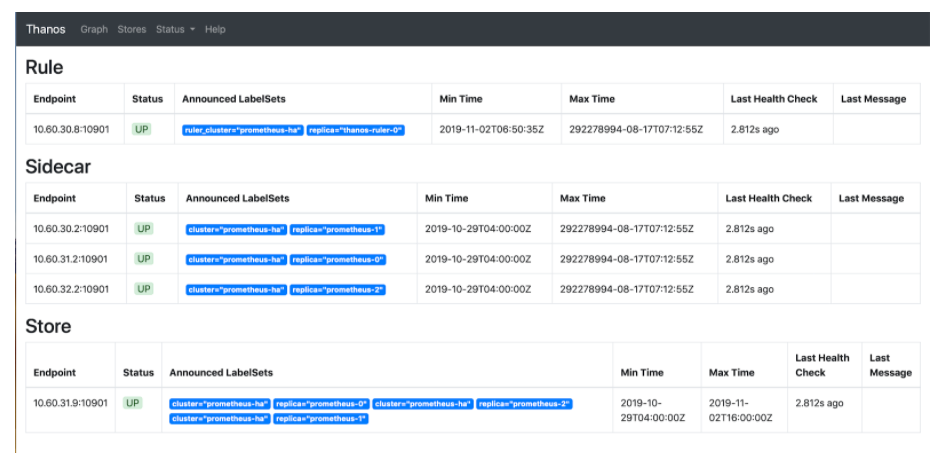
现在你可以在Grafana中添加Thanos Querier作为数据源,并开始创建dashboard。
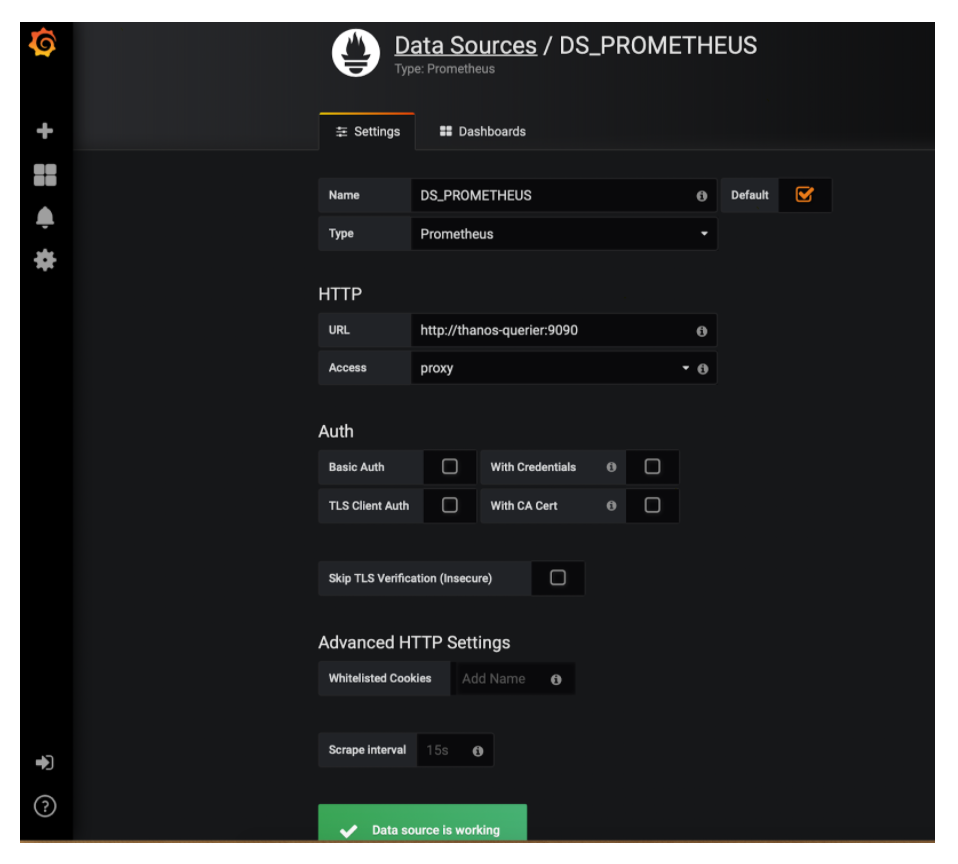
Kubernetes集群监控dashboard
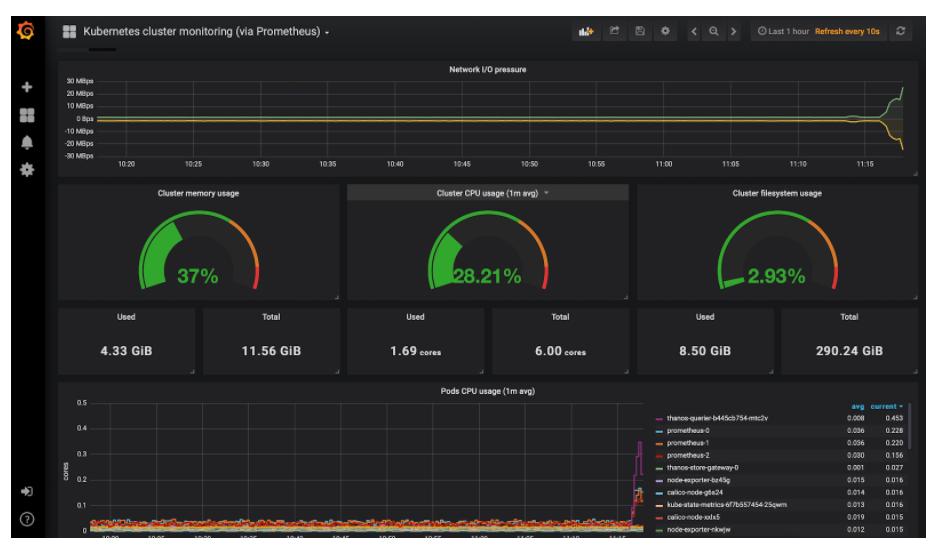
Kubernetes节点监控dashboard
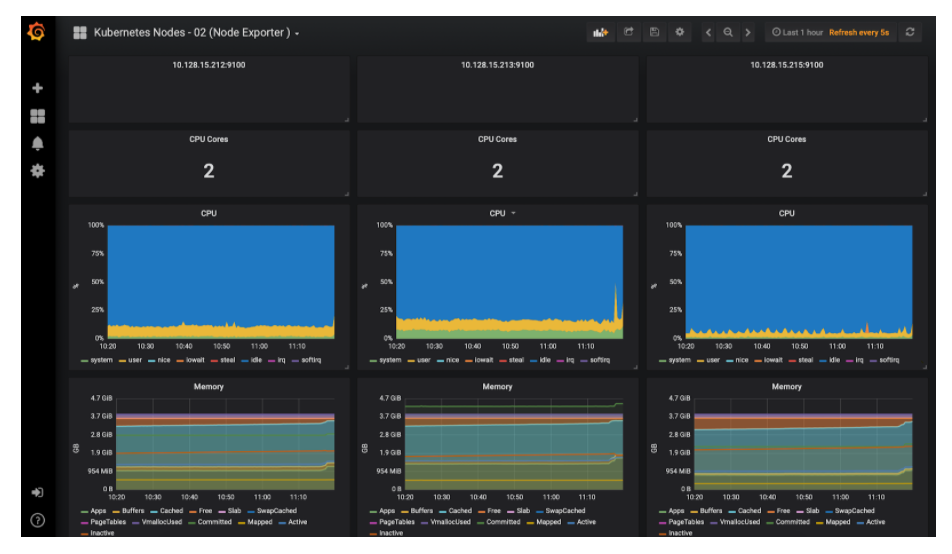
总 结
将Thanos与Prometheus集成在一起,无疑提供了横向扩展Prometheus的能力,而且由于Thanos-Querier能够从其他querier实例中提取指标数据,因此实际上你可以跨集群提取指标数据,并在一个单一的仪表板中可视化。
我们还能够将指标数据归档在对象存储中,为我们的监控系统提供无限的存储空间,同时从对象存储本身提供指标数据。这种设置的主要成本部分可以归结为对象存储(S3或GCS)。如果我们对它们应用适当的保留策略,可以进一步降低成本。
然而,实现这一切需要你进行大量的配置。上面提供的manifest已经在生产环境中进行了测试,你可以大胆进行尝试。